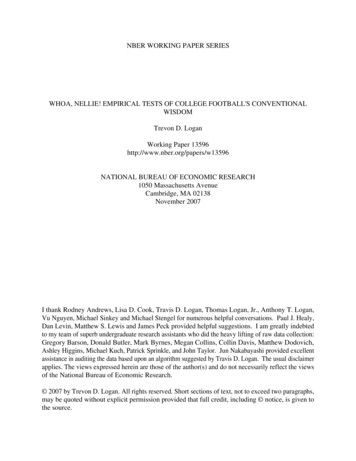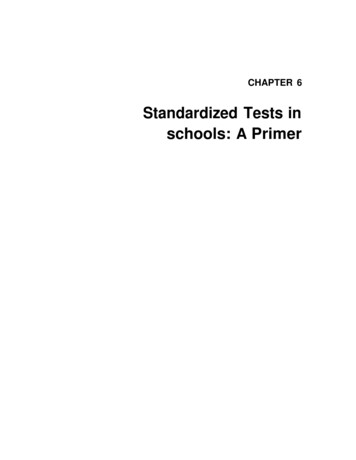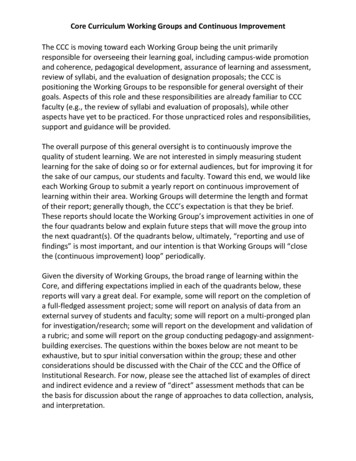
Transcription
NBER WORKING PAPER SERIESWHOA, NELLIE! EMPIRICAL TESTS OF COLLEGE FOOTBALL'S CONVENTIONALWISDOMTrevon D. LoganWorking Paper 13596http://www.nber.org/papers/w13596NATIONAL BUREAU OF ECONOMIC RESEARCH1050 Massachusetts AvenueCambridge, MA 02138November 2007I thank Rodney Andrews, Lisa D. Cook, Travis D. Logan, Thomas Logan, Jr., Anthony T. Logan,Vu Nguyen, Michael Sinkey and Michael Stengel for numerous helpful conversations. Paul J. Healy,Dan Levin, Matthew S. Lewis and James Peck provided helpful suggestions. I am greatly indebtedto my team of superb undergraduate research assistants who did the heavy lifting of raw data collection:Gregory Barson, Donald Butler, Mark Byrnes, Megan Collins, Collin Davis, Matthew Dodovich,Ashley Higgins, Michael Kuch, Patrick Sprinkle, and John Taylor. Jun Nakabayashi provided excellentassistance in auditing the data based upon an algorithm suggested by Travis D. Logan. The usual disclaimerapplies. The views expressed herein are those of the author(s) and do not necessarily reflect the viewsof the National Bureau of Economic Research. 2007 by Trevon D. Logan. All rights reserved. Short sections of text, not to exceed two paragraphs,may be quoted without explicit permission provided that full credit, including notice, is given tothe source.
Whoa, Nellie! Empirical Tests of College Football's Conventional WisdomTrevon D. LoganNBER Working Paper No. 13596November 2007JEL No. C8,D7ABSTRACTCollege football fans, coaches, and observers have adopted a set of beliefs about how college footballpoll voters behave. I document three pieces of conventional wisdom in college football regardingthe timing of wins and losses, the value of playing strong opponents, and the value of winning by widemargins. Using a unique data set with 25 years of AP poll results, I test college football's conventionalwisdom. In particular, I test (1) whether it is better to lose early or late in the season, (2) whether teamsbenefit from playing stronger opponents, and (3) whether teams are rewarded for winning by largemargins. Contrary to conventional wisdom, I find that (1) it is better to lose later in the season thanearlier, (2) AP voters do not pay attention to the strength of a defeated opponent, and (3) the benefitof winning by a large margin is negligible. I conclude by noting how these results inform debatesabout a potential playoff in college football.Trevon D. LoganThe Ohio State University410 Arps Hall1945 North High StreetColumbus, OH 43210and NBERlogan.155@osu.edu
“Football represents and embodies everything that's great about this country.”- Wayne Woodrow “Woody” Hayes“When they look back at that 9-1 season, they don’t ask who the nine were.”-Gen. Robert NeylandCollege football occupies a singular place in the sports and cultural landscape. Since Rutgersdefeated Princeton (6-4) on November 6, 1869 college football has been a central part of bothsports and collegiate folklore.1 The reach of college football, when compared to other amateur orcollegiate sports, is enormous. The stadiums that house the major college football powerhousesdwarf their professional counterparts, with several stadiums seating more than 100,000 spectators,and even more teams with consecutive sellout records that top 200 games.2 College football is alsobig business—revenues generated by college football average more than 35 million per school insome conferences and bowl appearances can net more than 15 million. The sustained tradition,pageantry, media attention, and excitement generated by college football are arguably unmatched inany other major American sport.3Part of this tradition is controversy, particularly when it comes to determining the best teamin a given season. Like most major sports, college football crowns a champion at the end of everyseason. Unlike most major sports, college football does not have a playoff system or any other hardrules to determine a champion. A key part of college football culture, then, is a never ending debateabout which team in a certain year was truly better than all others. While being listed as the numberone team in the country in the final Associated Press (AP) or Coaches’ poll is seen by almost all1Although the game of American football has its origins in rugby, which developed in England in the middle of the 19thcentury, organized American football actually predates organized rugby in England.2For example, Michigan’s Michigan Stadium has seated more than 100,000 spectators since 1956, and Nebraska’sMemorial Stadium (current capacity above 80,000) has been sold out for every home game since 1962. On average, ateam will play at home only 6 games per season—streaks of 200 or more imply home sellouts for more than 30 years.3For example, more than half of all US televisions were tuned in to the Texas-Arkansas game in 1969, and the ArmyNavy game of 1926 attracted a crowd of more than 100,000 (MacCambridge 2005). In some locations, polictics take aback seat to college football. In 2006 the recount of the contested election in Ohio’s 15th congressional district wasdelayed by one day so that county election officials could watch the Ohio State-Michigan game.1
observers to be a national championship, there are no set rules for how either the AP or theCoaches’ polls should determine which team is best.4Since there are no formal rules for determining a champion, college football has adopted aset of “conventional claims” about what a team has to do to be ranked highly at the end of theseason. It is generally believed that a loss at the “wrong” time or a close victory over a “weak”opponent can cost a team a chance to claim a national title. Moreover, observers have noted that itis better to lose early in the season rather than later, because a team’s later performance will weighheavily in how others view a team. Another piece of conventional wisdom is that a team is rewardedfor playing (and winning against) strong opponents. Lastly, some have noted that large margins ofvictory are necessary to obtain or retain a high ranking because such victories receive “style” pointsas they reflect a team’s dominance.As with most pieces of conventional wisdom, the bases for these assertions are anecdotal,“everybody knows” stories. Implicit in these assertions, however, are empirical claims that can andshould be tested.5 Even more, these claims embody implicit notions about how voters in the collegefootball polls behave. Since the plural of anecdote is not evidence, this paper takes these pieces ofconventional wisdom seriously and is the first paper I am aware of that puts them to the test. Inparticular, I test three pieces of college football’s conventional wisdom: (1) that it is better to loseearlier in the season than later in the season, (2) that teams are rewarded for playing strongeropponents, and (3) that winning by wide margins earns a team “style” points that result in improvedrankings. To test these propositions this paper exploits a newly created data set of week-by-weekAP poll results for 25 of the most prominent college football teams over a 25 year period. This largeand rich source of data allows us to look at each of these pieces of conventional wisdom to see ifwhat “everybody knows” turns out to be true empirically.4The NCAA lists ten organizations that bestow national championships in college football, some of them retroactively.2
I find that the conventional wisdom of college football is wrong. Rather than beingpenalized for losing later in the season, teams are actually rewarded for losing late in the season. Infact, this premium for losing late is sizable— teams that lose late in the season are re-ranked higherby roughly 3/4 of AP poll voters than they would have been if they had lost early in the season.Even if one wished to argue that an early loss gives teams more time to make up ground in therankings, the results here suggest that late losses leave teams with less ground to make up. Similarly,defeating strong opponents does not yield any advantage in terms of ranking, but losing to strongopponents helps. Margin of victory matters—but only if you lose. While winning by large marginsdoes not confer any ranking advantage (despite numerous claims to the contrary), losing by ablowout hurts, and losing to a strong team does not soften the blow.The lack of support for the conventional wisdom of college football does have implicationsfor some current debates surrounding the sport. Recently, sports enthusiasts have strengthenedtheir calls for a playoff system in college football, and others have called for early-season teamrankings to be banned. These results suggest that determining a playoff based on the rankings ofteams at the end of the season will need to be adjusted so as not to factor heavily the timing oflosses (if the timing of a loss is exogenous to a team’s true quality). As such, determining the four(or eight or sixteen) teams that would make a playoff could be complicated by the fact that thetiming of losses matters. Teams may be out of playoff contention if they lose an early game, yetremain in contention if they lose a game late in the season.What these findings imply for scheduling and conference alignments in the future, however,is unclear. Since strength of the opponent is not a factor, teams may be better served by avoidinggames against strong opponents throughout the season, and this can work to the advantage of teamsin weak conferences and naturally to the disadvantage of teams from strong conferences and/or5Fogel (1975) makes this same point about implicit quantitative claims in history.3
non-conference schedules if strong opponents increase the probability of losing. It may bebeneficial, however, to schedule strong opponents later in the season. Also, since large margins ofvictory are not rewarded in the AP rankings, teams have little incentive to “run up the score” onopponents, something coaches have claimed they must do to retain or obtain a high ranking.These results have implications beyond college football. Tests of college football’sconventional wisdom are actually modified tests of voter behavior. This paper offers a novel test ofa particular type of behavioral model—the primitive voting model generated out of conventionalwisdom. Although the example here is highly structured and applies to college football only, ourideas about voting behavior in general are largely guided by conventional wisdom, but usuallydifficult to estimate empirically since popular elections are one-time only events. Beyond a series oftests of voter behavior in college football, this paper makes another contribution. Despite the largeliterature on college football rankings, particularly among statisticians and mathematicians (Callaghanet al. 2004), and the work about the efficiency of the rankings, particularly among economists (Fairand Oster 2007), little work exist that tests voter behavior in the rankings themselves. While modelsof team rankings have been devised by a number of experts, we know little about how votersactually vote in the polls and what evidence they take as the most salient.I begin the next section with a brief history of college football and by documenting the threepieces of college football’s conventional wisdom that I later test, which are espoused by fans,coaches and sportscasters. In particular, I use the narrative record— news reports, sportswritercolumns, fan blogs and message boards—to establish the widespread nature of the conventionalwisdom. I then discuss the data that I assembled to test these propositions and present the centralempirical results of the paper which refute the conventional wisdom of college football. Next, Iconsider alternative specifications to test the robustness of the results, and I conclude by discussingwhat these results imply for current debates about a playoff in college football.4
I. College Football Facts and MythsA. College Football’s EvolutionFrom its beginnings in the late nineteenth century, college football soon blossomed into amajor American sport by the turn of the last century. Since professional football did not begin in asustained organized form until the 1920s, college football was the source of the sport’s origins andfirst innovations. In fact, such standard features of the game as the line of scrimmage, first downs,and even the points awarded for scoring were all decided in college football’s formative years in thelate nineteenth century.6 The creation of mascots, fight songs, and the grouping of teams intoleagues and conferences all took hold during college football’s formative years. But college footballat this time, even at the highest levels, was anything but the revenue generating spectacle that it istoday. Even into the early 20th century, many prominent teams had no official coach, and most ofthose who coached did so on a part-time basis. The sport was a particularly controversial feature onsome college campuses due to its violent nature. As early as 1905 President Roosevelt wasthreatening to ban the sport based on its brutality (more than 100 players had been killed in the 1905season), which led to the creation of the National Collegiate Athletic Association (NCAA) to deviserules for the game.7 Despite this threat, by the early twentieth century college football’s popularitywas beyond question.The early years of the sport were dominated by private universities, in contrast to today’s topprograms. Although not officially a league until the 1950s, the Ivy League was the first powerconference in college football—Harvard, Yale, and Princeton have a combined total of more thanthirty national championships in the sport, the vast majority earned before the Great Depression.Concerns about the place of sports at these schools, however, led to an agreement in late 1945 that6For a basic introduction to the game of football by (and for) an economist, see Romer (2006).In the 1905 meeting between President Roosevelt and representatives from Harvard, Yale, and Princeton, it wassuggested that the width of the playing field be increased by 40 feet to prevent injuries. Harvard representatives rejected75
signaled the beginning of the end of major college football at elite universities. The Ivy GroupAgreement ended football scholarships among the member schools, and in 1954 banned bowlgames, spring practices, and decreed that student athletes should be “representative” of the studentbody. While these schools de-emphasized the sport, other schools built up their programs, and bythe mid-twentieth century college football’s popularity had been codified with larger-than-lifecoaches, storied rivalries, weekly polls (the AP poll began in 1936), bowl games (the Rose bowl hasbeen played annually since 1916), national championships, and the formation of athletic conferenceswhose champions would compete in bowl games.Several features of what can be termed contemporary college football are fairly recent inorigin, however. Traditionally, the national champion was determined before the bowl seasonbegan, and historically few teams had the option of playing in the postseason.8 Bowl games wereseen, originally, as a prize for a well-played season. In fact, the Big Ten conference began allowingmore than one team to play in a bowl game in 1975, and the conference at one time did not allowback-to-back bowl appearances by the same team.9 Notre Dame, under a multi-decade self-imposed“no bowl games” policy, would be crowned national champions more than five times while notappearing in any postseason matchups. As such, the focus on bowl games and the postseason as ameans of determining the best team in a given season is a recent phenomenon. Similarly, while thepower in college football has changed from elite private universities such as Harvard and Princetonto public universities such as Alabama and Oklahoma, other changes have sought to bring parity tothe idea since they had recently completed construction of Harvard Stadium. As a compromise, the forward pass wasinvented (MacCambridge 2005).8The AP began ranking teams after bowl games in 1965, and the Coaches’ poll began doing so five years later.9This is largely due to the complaints of Michigan fans following a 10-10 tie in the 1973 Ohio State – Michigan game.The athletic directors of the schools in the Big Ten voted on who would represent the conference in the Rose Bowl, theonly bowl the conference played in. When Ohio State won the vote, Michigan fans and supporters complained, andeventually the conference allowed more bowl tie-ins.6
the sport.10 Beginning with scholarship restrictions, recruiting guidelines, the extension of theregular season to eleven games, and academic requirements in the 1970s, the NCAA brought abouta new college football landscape, where teams with little or no tradition could gain a foothold if theadministration was committed to developing a football program and if a program could recruit topathletes.11The largest change in college football in its modern form is the exposure of the sport to ageneral audience. In the early days of television, the NCAA decided which games would bebroadcast. Traditionally, the television coverage favored teams with strong national reputations andstoried histories (such as Notre Dame or Michigan), and many individual teams, as well asconferences, wanted to allow consumers further choice. The decision in NCAA v. Board of Regents ofUniversity of Oklahoma and Georgia Athletic Association (1984) allowed college football conferences toschedule their own games. This de-regulation, along with the growth of cable and satellite televisionoutlets, meant that college football was now the focus of more television hours than ever before.The exposure of teams with less storied traditions has been most pronounced, and many teams thatnow count themselves among the established teams in the college football landscape (Miami (FL),Wisconsin and Virginia Tech, for example) did not have a large number of winning seasons beforethese institutional changes.12 Another change brought about by college football’s massive media10Football is the only NCAA sport that sub-divides the Division I schools. Beginning in 1978, Division 1A (nowreferred to as the bowl division) required (1) an average attendance of 15,000 per home game over a 2 year period, (2)that 60% of games be played against Division 1A opponents, and (3) the schools to grant athletic scholarships. Division1AA (now referred to as the championship division, as this division’s champion is decided through an NCAA organizedplayoff) does not require scholarships or attendance minimums.11Before the NCAA intervened, players could be offered scholarships and other incentives (up to and including pay) tobe football players. Originally, the NCAA sought to ban the practice of awarding athletic scholarships in 1947, but thiswas met with fierce resistance (and outright violations). In 1951 the NCAA allowed scholarships, and also establishedrules for recruiting athletes. The number of scholarships that could be offered was limited in 1977 to 95 scholarships.This has been reduced over time, and the football scholarship limit is currently 85. Depken and Wilson (2006) show thatNCAA enforcement increased the competitive balance of college football.12Incidentally, conventional wisdom held that college football would be less competitive with the deregulation oftelevision coverage. For example, when Notre Dame signed its exclusive television contract with NBC in 1990 (effectivefor the 1991 season and renewed thereafter), it was widely believed that Notre Dame would dominate college footballbecause they could ensure to any potential recruit that they would receive a large amount of television exposure (a major7
exposure is the culture of college football itself—smaller rivalries are made known nationwide,teams with little traditions can rise to prominence, and recruits may choose to play for schools thatwill allow them to play earlier than those with deeper rosters.Against this backdrop, it was not until the 1970s that football achieved steady progress inracial integration. In a sport that is now majority black at the highest levels (both college andprofessional) the exclusion (and later inclusion) of black athletes from certain teams’ rosters wouldobviously change the complexion of the game. College football’s integration mirrored that of therest of the country, with Texas’ 1969 national championship team the last all-white team to win atitle. While Miami and Kentucky (1966) did sign black players to their rosters in the 1960s, southernschools did not begin integrating their rosters, en masse, until the 1970s.13 Before full integration,integrated teams would, by agreement, sit their black players when playing at the home site of asegregated team if a school so stipulated.14 Racial segregation also created curious recruitingstrategies, where integrated teams would recruit black southern athletes to their institutions becausethey would not be recruited by the major college football programs in their region.These changes have arguably heightened the drama of autumn Saturday afternoons. Asparity progresses the goal of a national championship is also arguably within the reach of moreschools than ever before. The goal of every program is to position itself best to play for a nationaltitle once the bowl season begins. While not losing any games is, without question, the best way torecruiting point at the time). Since Notre Dame signed the television contract in 1990 they have not won a nationalchampionship. Some of these claims are controversial, however, and products of conventional wisdom themselves—Sutter and Winkler (2003) argue that scholarship limits have increased parity among the top 20 teams, but not overall.13Resistance to integration in college football was pronounced. In December of 1955, the governor of Georgia askedGeorgia Tech to reject an invitation to the Sugar Bowl because their opponent, Pittsburgh, had black players on theroster. Shortly thereafter, Louisiana legislators banned all colleges from competing against schools with black players.14In college football mythology, the USC-Alabama game on September 12, 1970 holds special interest. In that game,two USC African American running backs, Clarence Davis and Sam Cunningham torched the all-white Alabama squad42-21. After the game, Alabama coach Paul “Bear” Bryant escorted Cunningham into the Alabama locker room andtold his players “Gentlemen, this is what a football player looks like,” at which point each player rose to shakeCunningham’s hand. While some have claimed that “Sam Cunningham did more to integrate Alabama in 60 minutesthat night than Martin Luther King, Jr. accomplished in 20 years,” (MacCambridge 2005, p. 48), Bryant had alreadyintegrated Alabama football, signing a black running back, Wilbur Jackson, in the Spring of 1970.8
accomplish that goal, it is actually rare that a team completes an entire season unscathed, and evenrarer that two and only two teams do so. Also, even if one does remain undefeated, it does notguarantee a spot in a desired bowl game—one can be shut out of the competition.15 To accomplishthis goal in light of the reality that teams with losses regularly end the season highly ranked,observers and fans have adopted “golden rules” (what I term here conventional wisdom) as to howa team can best position itself to be highly ranked in the polls at the end of the regular season. Evenif one does not make it to the designated “national championship” game, the gains to being close aresubstantial as BCS bowl appearances come with payouts in excess of 15 million. These “goldenrules” are largely a product of the recent, post 1970s college football landscape—they incorporateideas of how teams should perform throughout the season to impress a subjective group of voters inpolls that determine a team’s position in the hunt for a national title and major bowl berth.B. College Football’s Conventional Wisdom1. “If you’re going to lose, lose early”The conventional wisdom of college football dictates that teams who lose early in the seasonstand a better chance of being highly ranked at the end of the season than teams who lose later. Thelogic is that teams who lose early have a greater opportunity to climb up in the polls after a loss, andalso a greater chance of leapfrogging teams that lose at later points in time. Also, since ranking inthe polls reflects recent performance, it is better to avoid losses late in the season. Similarly, thewisdom holds that voters view late losses unfavorably as they are a signal of low team quality.This view is widely held among fans and observers. Below is a sampling of the logic offeredby fans in sportsblogs and message boards, where this piece of conventional wisdom is mostpronounced:15A recent example would be the undefeated Auburn team of the 2004 season.9
“It is better to lose early than late.”16“Even if you follow the logic that one loss takes the college team out of contention, you stillhave flawed logic. When Michigan lost, there were dozens of people on here who said, ‘It'sbetter to lose early than it is to lose late. Michigan can still be in it if they win all theirgames.’”17“There is a small part of me that would love to see that [Michigan in the Rose Bowl], just toprove the fact that a loss early in the year doesn’t count as much as a loss at the end of theyear.”18“This season will demonstrate perfectly why it is better to lose early than late. It might makebig time rivalries like Ohio State-Michigan move their matchup to early or mid-season sothat both team still have a chance to recover and make the national championship game.”19“I still say all things being equal, if I am a coach with national championship aspirations, Iwould rather lose to an unranked team in week 5 than the number one team in week 10.”20“In college football, it is not about who you lose to, but when you lose. If you are going tolose, you always want to lose early. Pollsters have notoriously horrible memories.”21Fans are not the only ones to assert that losing early in the season is better than losing later. Sportscolumnists have also made such claims.“The [LSU] Tigers haven't lost to the [Mississippi State] Bulldogs since 1999 - and theyhistorically own them - but if you're going to lose, lose early.”22“However, if the [Georgia] Dawgs keep on winning, beat Florida, win the [SoutheasternConference] East [division], and upset LSU, then yeah the South Carolina loss doesn’t lookas bad. The pollsters have short memories That’s why the computers are so important inthe BCS formula; they don’t care when you lose.”23“History has shown us that it is better to lose early than lose late.”24“If you lose a game, just make sure it isn’t close to the end of the iewtopic.php?t 1818 e-football-top-25-updated-for-week-5/19 her Report s College Football Top25 Week 8 php?t 5423421Ibid.22Caparell (2007).23Fiutak (2007).24Reback (2007).25Barra (2001).161710
“It used to be that you could lose early and come back into the national championshippicture with some help. This year, however, there’s already been an inordinate amount of“help” being thrown around. So much so, that no more is needed. Teams just need to focuson taking care of their own business.”26The assertion that it is better to lose earlier in the season than later is an empirical assertionabout how pollsters weigh wins and losses as a function of the week of the season in which they areplayed. For example, many of the thoughts on this topic contain a notion that poll voters are“forgetful” or “myopic” in their behavior, to the extent that they weigh evidence differently. In thisway, the order of the signal matters. The logic is that it is better to send a bad signal early than latebecause there are fewer opportunities to make up for it.The implicit ideas in this particular piece of conventional wisdom do contain pieces of recenteconomic models of behavior. The conventional wisdom would be consistent by inference from theLaw of Small Numbers, to the extent that if a promising team loses early, and promising teams havefew loses, then losing early allows one to predict future wins with higher probability (Rabin 2002).Similarly, one could pose that there are issues of problems in Bayesian updating or projection bias(Lowenstein, O’Donoghue and Rabin 2003). This notion of the value of the timing of a loss runscounter to the notion of confirmatory bias, however, because in that case later losses would be seenas particularly non-representative of a team’s quality (Rabin and Schrag 1999).2. There’s a Benefit to Playing (and Defeating) Strong OpponentsAll else equal, teams should be rewarded for playing (and defeating) opponents who have strongrecords. While observers have long noted that this is true, the way in which opponent strengthshould be measured remains unclear. By convention, one has played a strong team if that that teamhas a high winning percentage. In the discussion of this issue, several terms are used, and here I use26Tamanaha (2007).11
them interchangeably.27 For example, one cannot have a “strong schedule” unless it includes“strong opponents,” and defeating “strong opponents” results in, by default, a “quality win.” TheBCS formula, in certain incarnations, took “strength of schedule” into account explicitly, and it hascaused teams to remain interested in the records of their opponents long after the game has beenplayed.Back when college football was propelled by clichés instead of a computer hard drive,Oklahoma Coach Bob Stoops would have stopped caring about Alabama about amillisecond after his Sooners p
Since Rutgers defeated Princeton (6-4) on November 6, 1869 college football has been a central part of both . big business—revenues generated by college football average more than 35 million per school in some conferences and bowl appearances can net more than 15 million. The sustained tradition, . rankings. To test these propositions .










